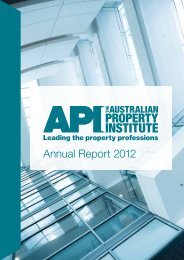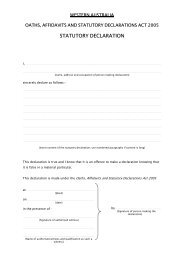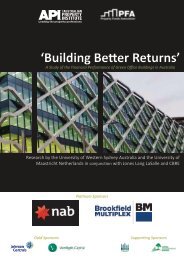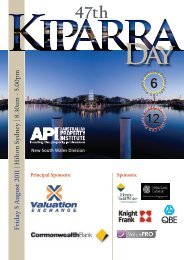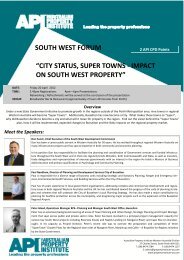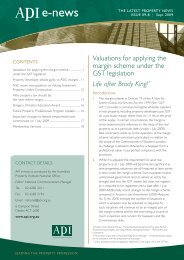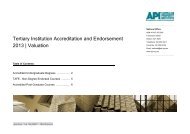VALUATIONS FOR INSURANCE PURPOSES
VALUATIONS FOR INSURANCE PURPOSES
VALUATIONS FOR INSURANCE PURPOSES
You also want an ePaper? Increase the reach of your titles
YUMPU automatically turns print PDFs into web optimized ePapers that Google loves.
ANZ VALUATION GUIDANCE NOTE 13<br />
commissioning costs and timeframes for plant<br />
and machinery insurance valuations;<br />
• planning scheme provisions which could affect<br />
whether a building can be rebuilt in its present<br />
form;<br />
• heritage issues;<br />
• general insurance policy terms (including in<br />
particular difference between reinstatement<br />
and indemnity, inclusions and exclusions, coinsurance<br />
and averaging provisions);<br />
• inflation on building costs;<br />
• market rental values (for loss of rent or<br />
allowance for alternative accommodation);<br />
• the size and extent of all improvements<br />
including building structures and ancillary<br />
improvements.<br />
2.0 Common Insurance Policies and Terms<br />
2.1 Background<br />
The following information is provided to assist<br />
Members in understanding the common types<br />
of insurance policies available and some of the<br />
terminology commonly used in those policies,<br />
but members should be aware that each policy<br />
of insurance could be subtly or dramatically<br />
different in how it defines the terms discussed<br />
below. The mechanism by which values or costs<br />
of reinstatement are calculated will differ in each<br />
policy of insurance.<br />
It is preferable for members to state whether they<br />
have or have not read or referenced the insurance<br />
policy associated with the property insured. If a<br />
policy has been referenced, a statement of any<br />
specific issues that have affected the member’s<br />
assessment should be noted, and if it has not been<br />
referenced, members should acknowledge the<br />
same and ensure that the basis of their assessment<br />
is clear to the party to whom the report is<br />
addressed.<br />
2.2 Common Insurance Policies<br />
There are many different types of insurance policies<br />
available. The most common policies relating to<br />
the insurance of buildings and contents are:<br />
2.2.1 Common Householders Policy:<br />
There are two main types of common<br />
householders policy:<br />
a Common policies where the insurer may<br />
elect to replace, repair, or indemnify in the<br />
event of a loss.<br />
b Replacement with new policies, which<br />
sometimes can have age provisions or can<br />
be regardless of age.<br />
2.2.2 Industrial Special Risk (ISR) Policy.<br />
The ISR policy is the most common policy for<br />
commercial/industrial insurance. This type of<br />
policy typically addresses many areas in addition to<br />
buildings and contents.<br />
Both of the above types of policies are most<br />
commonly offered on the basis of reinstatement<br />
cost and/or indemnity value, however, other<br />
valuation bases such as reproduction cost or<br />
replacement cost can also apply.<br />
2.3 Insured<br />
The insured is a person or entity whose interests<br />
are protected by the insurance policy.<br />
2.4 Situation<br />
Situation is a term commonly used in insurance<br />
policies to refer to the specific location of the<br />
insured assets. The insured may have many<br />
situations covered by the same insurance policy.<br />
2.5 Property Insured<br />
Property insured is a term commonly used to<br />
describe the property that is covered under the<br />
insurance policy. Insurance policies typically<br />
provide insurance cover for all real and/or personal<br />
property of every kind and description, unless<br />
specifically excluded, belonging to the insured<br />
or for which the insured is responsible or has<br />
assumed responsibility to insure.<br />
In some circumstances a property owner may selfinsure<br />
some assets and these should be identified.<br />
The property insured also extends to all property<br />
in which the insured may acquire an insurable<br />
interest during the period of insurance. An<br />
insurable interest may result from the completion<br />
of an agreement to purchase an asset even though<br />
settlement may occur at a future time.<br />
2.6 Declared Value and Sum Insured<br />
Declared value and sum insured are terms used<br />
to describe the sum total of all property insured<br />
at each situation declared by the insured and<br />
calculated in accordance with the basis of<br />
8.13.2<br />
ANZ VALUATION AND PROPERTY STANDARDS



